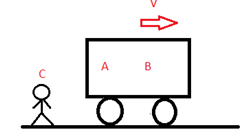What is a frame of reference?
We have learned about velocity, acceleration, and displacement. But all these quantities need a frame of reference from which they are measured.
In physics, a frame of reference consists of an abstract coordinate system and the set of physical reference points that uniquely fix the coordinate system and standardize measurements within that frame.
Let’s consider the following figure:
In the video, the first degree of monoatomic, diatomic and triatomic gases are explained.

Types of frame of reference
- Inertial Frame of Reference
- Non-inertial Frame of Reference
Inertial Frame of Reference
An inertial frame of reference is a frame where Newton’s law holds true. That means if no external force is acting on a body it will stay at rest or remain in uniform motion. Suppose a body is kept on the surface of the earth, for a person on earth it is at rest while for a person on the moon it is in motion so which is my inertial frame here?
Actually, the term inertial frame is relative i.e. first we assume a reference frame to be the inertial frame of reference. So a more general definition of an inertial frame would be: Inertial frame is at rest or moves with constant velocity with respect to my assumed inertial reference frame.
Non-inertial Frame of Reference
Now we can define a non-inertial frame as a frame that is accelerated with respect to the assumed inertial frame of reference. Newton’s law will not hold true in these frames. So in the above example if I assume earth to be an inertial reference frame the moon becomes a non-inertial reference frame as it is in accelerated motion with respect to earth. But if we want to make Newton’s law hold here we need to take some mysterious forces also known as pseudo forces.
Watch how to solve problems related to frame of reference






Discuss earth as a frame of reference
Earth is a non-inertial reference frame.
Explanation: By now, we are aware of the fact that an inertial frame of reference is a reference frame where an object is either moving with a constant velocity or at rest. In such a frame, there is no net force acting on an object as a result the object is not accelerated. However, in a non-inertial reference frame, the motion of an object is acted upon by fictitious forces and other forces due to external action.
Earth rotating about its own axis causes an external force that results in the acceleration of the motion of objects. This indicates that the Earth is not an inertial reference frame.
Can we consider an object doing circular motion as non-inertial?